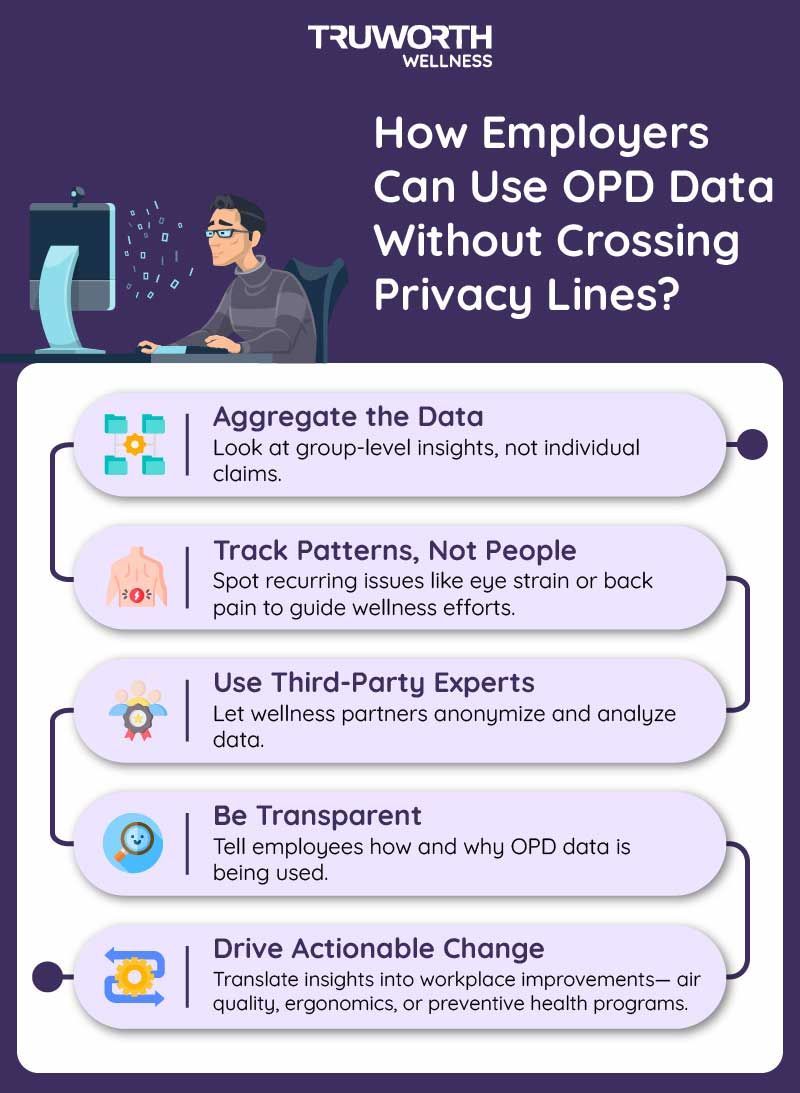How Employers Can Use OPD Data To Spot Health Trends? (Without Breaching Privacy)

Employee well-being is no longer just about providing health insurance or the occasional fitness session. Organizations today are expected to create workplaces that support long-term health, productivity, and resilience. One powerful but often underutilized tool in this journey is OPD (Outpatient Department) data.
OPD benefit utilization reflects everyday health needs, from doctor consultations to diagnostic tests, physiotherapy, or pharmacy expenses. When analyzed ethically, this data can offer employers a bird’s-eye view of workforce health trends. However, the challenge is balancing insight with privacy. The question is: how can organizations use OPD data responsibly, without making employees feel monitored?

Why OPD Data Matters for Employers?
While hospitalization data captures severe health incidents, OPD data paints a more frequent and relatable picture of employee well-being.
- Real-life relevance: OPD data highlights common conditions employees actually visit doctors for, like headaches, back pain, allergies, or recurring infections.
- Preventive potential: Spotting early indicators of lifestyle diseases such as hypertension or diabetes can help employers design preventive interventions.
- Workplace connection: Many OPD trends, like rising eye strain or musculoskeletal issues, are linked directly to workplace environments, making them highly actionable.
Put simply, OPD data allows companies to move from reactive healthcare spending to proactive wellness planning.
Also Read: The Role Of OPD Wellness Programs In Employee Health And Company Success
The Privacy Dilemma
Health information is deeply personal, and employees naturally worry about how their data might be used. If mishandled, it can lead to mistrust and disengagement from wellness programs. This makes privacy protection non-negotiable.
Employers must avoid collecting or accessing individual medical details. Instead, the focus should be on aggregated, anonymized data that highlights patterns, not people. The aim is not to know who is sick, but to understand what health challenges are becoming common across the workforce.
How Employers Can Ethically Use OPD Data?
1. Aggregate, Don’t Isolate
Instead of looking at individual claims, employers should work with summarized data. For example, if 35% of claims over the past year relate to physiotherapy or orthopedic consultations, it may suggest widespread ergonomic issues at the workplace. This insight can then guide investment in better seating, posture workshops, or workplace flexibility.
2. Focus on Trends, Not Identities
The value lies in identifying what’s becoming common, not in knowing who’s affected. For instance:
- A surge in respiratory-related OPD visits could indicate poor indoor air quality.
- Frequent eye-related claims may highlight the effects of long screen hours.
- An increase in digestive issues could signal workplace dietary habits.
Spotting these patterns allows employers to act collectively, creating preventive measures without ever singling out individuals.
3. Leverage Third-Party Expertise
To maintain objectivity and protect confidentiality, organizations should rely on wellness partners, insurers, or health analytics providers. These experts can handle sensitive data, apply robust anonymization, and deliver insights in a way that shields individual identities. Employers receive only the “what,” never the “who.”
4. Build Transparency and Trust
Employees are more likely to engage with wellness initiatives when they know their data is safe. Communicate clearly:
- What kind of OPD data is being studied?
- Why is it being analyzed?
- How will it benefit employees? (better programs, improved coverage, healthier workplaces)
By being upfront, companies show respect for employee autonomy and earn their confidence.
Also Read: The Role Of OPD Wellness Programs In Employee Health And Company Success
Practical Applications of OPD Data Insights
Here are some examples of how OPD analysis can translate into meaningful wellness initiatives:
- Respiratory health trends: If there’s a spike in respiratory infections, employers can review office ventilation, introduce air purifiers, and run awareness drives on flu vaccinations.
- Eye care: High OPD claims for eye consultations could lead to digital eye strain workshops, mandatory screen breaks, or subsidies for anti-glare lenses.
- Musculoskeletal health: Frequent back pain and orthopedic consultations may point toward the need for ergonomic chairs, sit-stand desks, or physiotherapy tie-ups.
- Lifestyle disease markers: Rising claims for hypertension or diabetes medications could spark targeted programs like nutrition counseling, fitness challenges, or stress management workshops.
- Pharmacy utilization patterns: By understanding which medicines are most in demand, employers can negotiate better pharmacy tie-ups and ensure affordability for employees and their families.
Balancing Insights with Privacy: Best Practices
Employers should adopt strict guardrails to ensure health data is used responsibly. Some golden rules include:
- No personal identifiers: All names, employee IDs, or personal details must be stripped from datasets before analysis.
- Limited access: Only authorized partners or wellness teams should handle raw data.
- Compliance checks: Follow all applicable data protection regulations to avoid legal or ethical risks.
- Feedback loop: Share findings and wellness improvements with employees, so they see the tangible benefits of data usage.
By embedding privacy at every stage, organizations demonstrate that they value both well-being and trust.
The Larger Payoff for Employers
Using OPD data isn’t just about reducing claims or saving costs. It signals a cultural shift, from being a company that reacts to illness to one that actively promotes health.
- Lower absenteeism: Addressing recurring health issues reduces sick days.
- Higher productivity: Healthy employees are more engaged, focused, and resilient.
- Cost efficiency: Preventive wellness programs reduce expensive hospitalization in the long run.
- Employer branding: A workplace that genuinely invests in wellbeing stands out in attracting and retaining talent.
In short, OPD data, when used responsibly, helps build not just healthier employees but also stronger organizations.
Conclusion
OPD data is more than numbers on medical claims; it’s a mirror reflecting workforce health trends. Employers who use this data responsibly can design smarter wellness programs, reduce future health risks, and improve overall employee satisfaction. The key lies in shifting the narrative: from surveillance to support, from cost control to care.
At Truworth Wellness, we specialize in turning anonymized OPD and healthcare data into actionable insights, always with privacy and ethics at the core. From spotting hidden health risks to designing preventive programs tailored to your workforce, we help organizations create a culture of wellness without compromising trust.